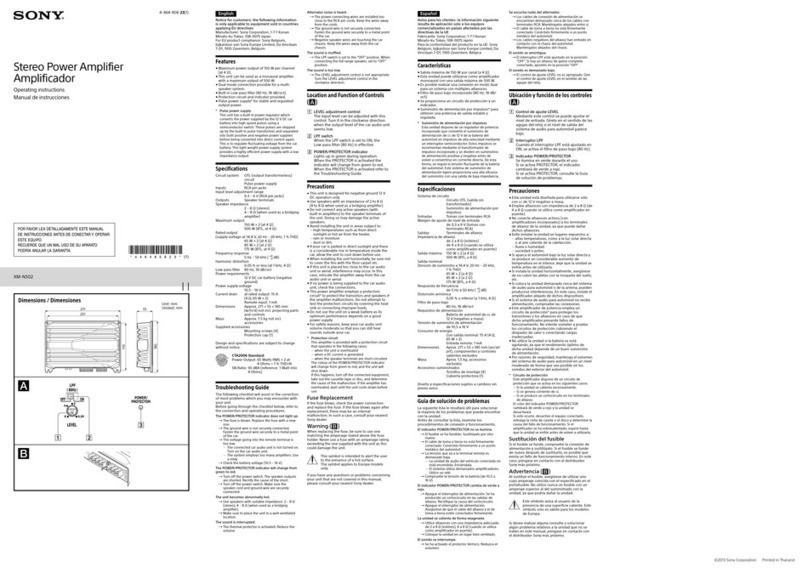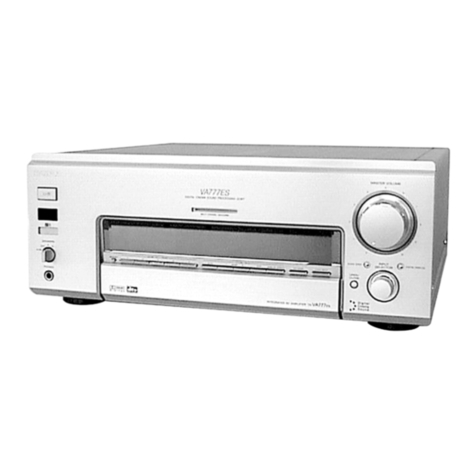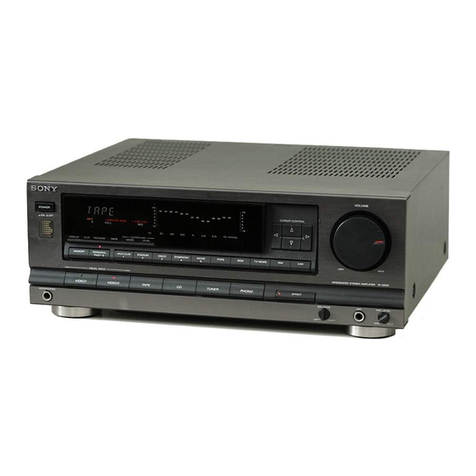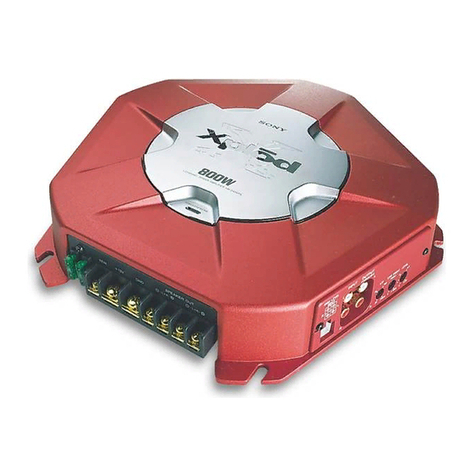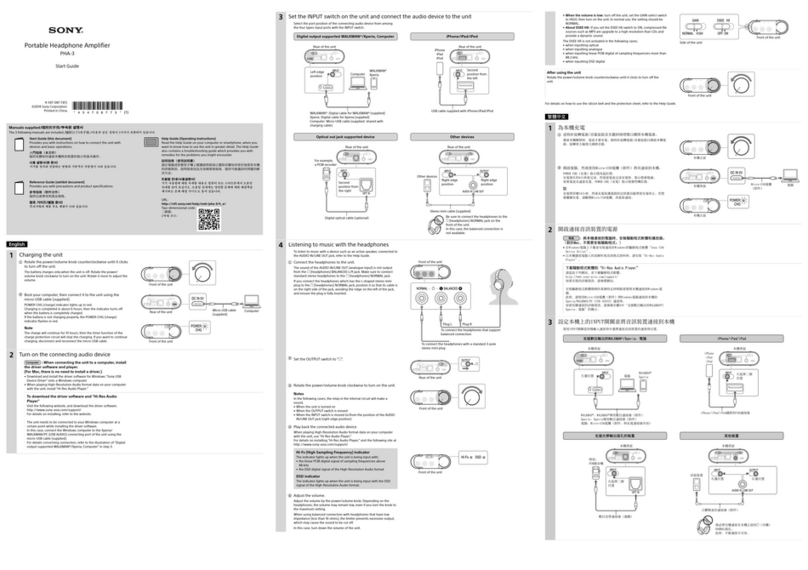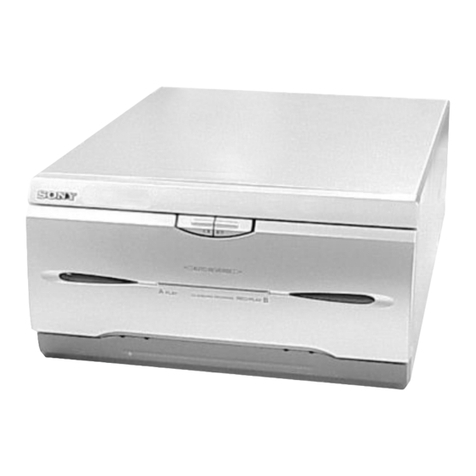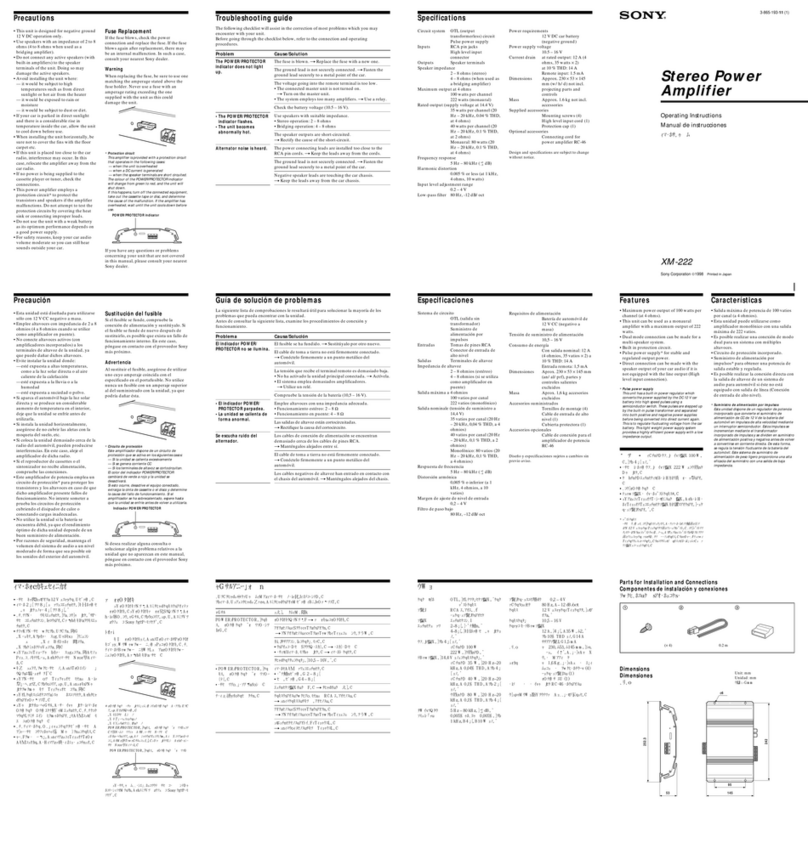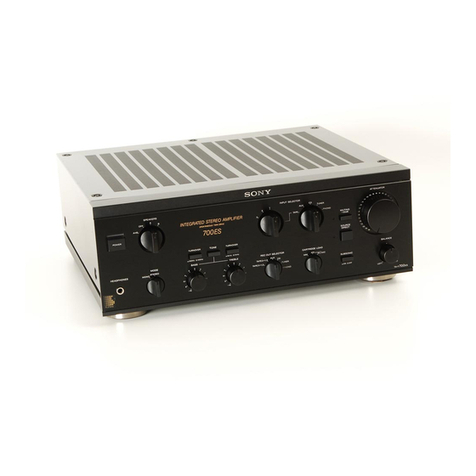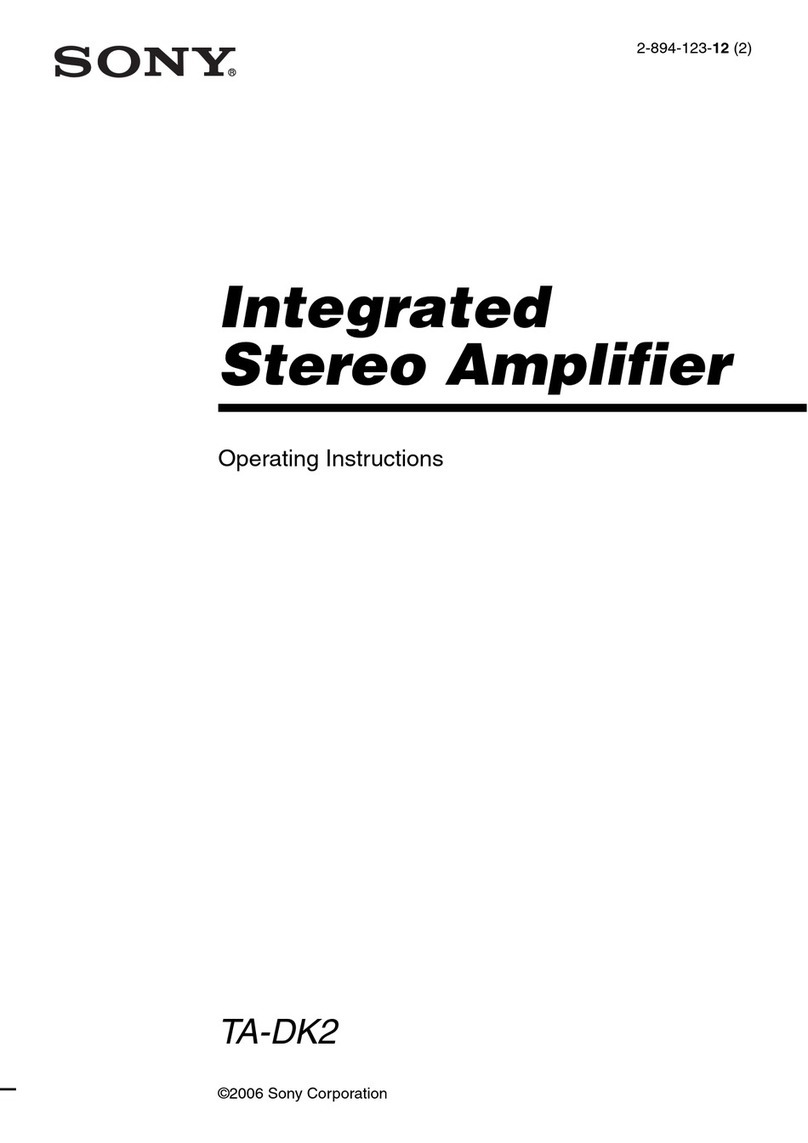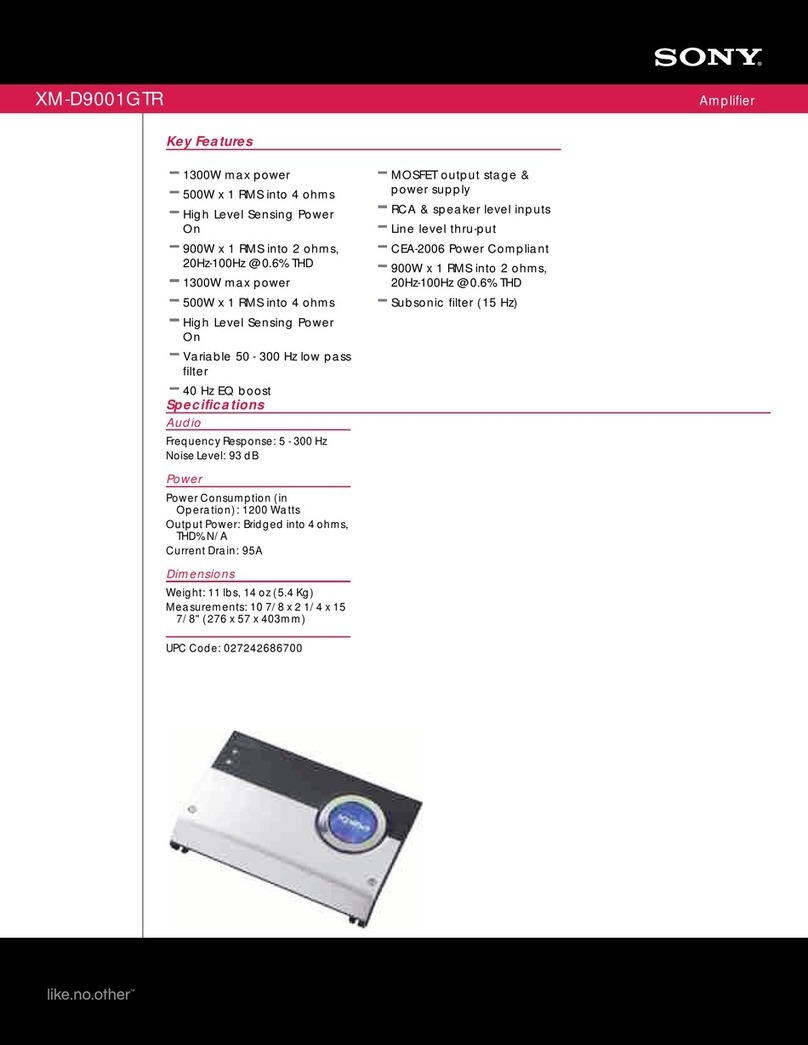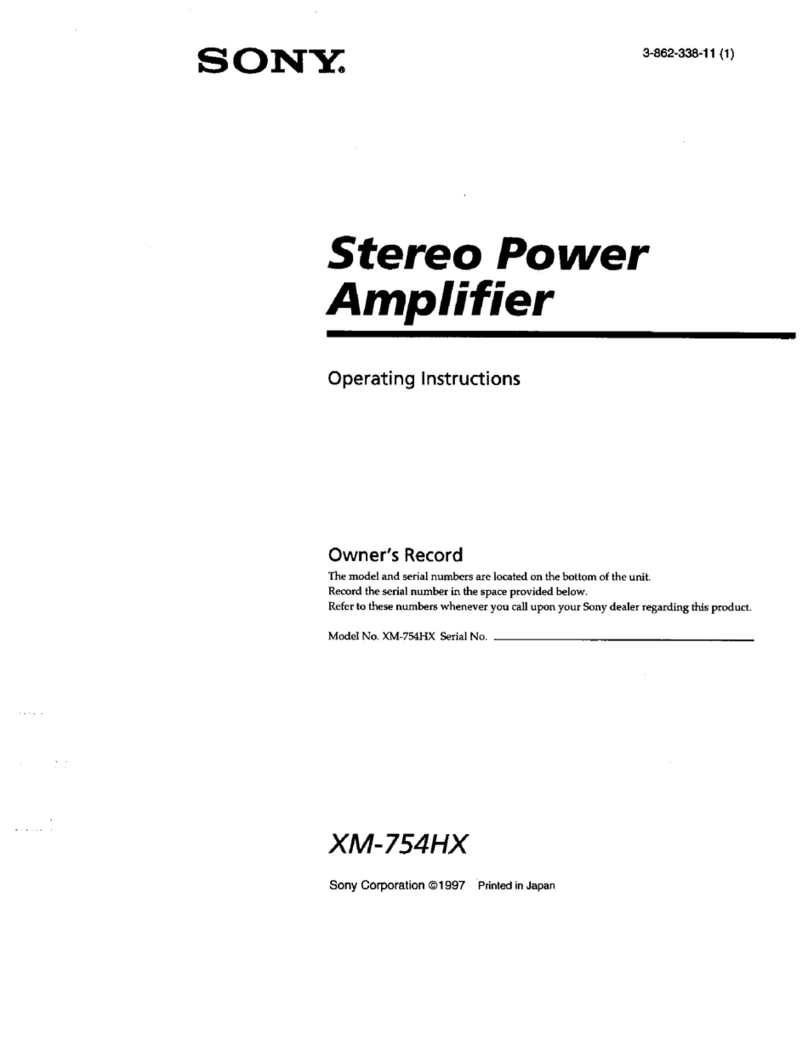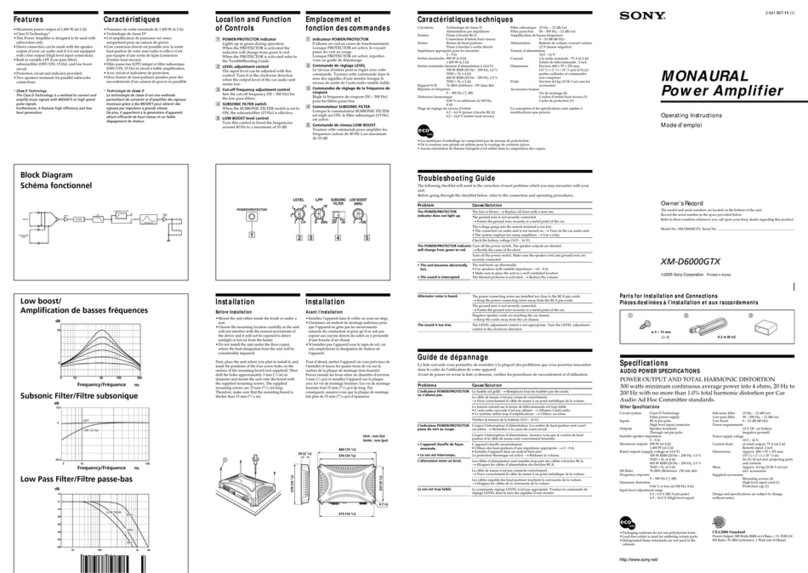
Especificaciones
The POWER/PROTECTOR indicator does not light up.
kThe fuse is blown. tReplace the fuse with a new
one.
kThe ground lead is not securely connected. tFasten
the ground lead securely to a metal surface of the car.
kThe voltage going into the remote terminal is too low.
• The connected master unit is not turned on. tTurn
on the master unit.
• The system employs too many amplifiers. tUse a
relay.
kCheck the battery voltage (10.5 – 16 V).
The OVER CURRENT indicator lights up in red.
kTurn off the power switch. The speaker outputs are
short-circuited. tRectify the cause of the short-
circuit.
The OFFSET indicator lights up in red.
kTurn off the power switch. Make sure the speaker
cord and ground lead are securely connected.
The THERMAL indicator lights up in red.
kThe unit heats up abnormally.
• Use speakers with suitable impedance (2 to 8 ohms).
• Make sure to place the unit in a well ventilated
location.
Sony Corporation 2000 Printed in Korea
XM-440EX
Specifications
3-045-652-61 (1)
Stereo Power
Amplifier
Operating Instructions
Manual de instrucciones
¤ˇ¥˛»¡'œfi
Troubleshooting Guide
The following checklist will assist in the correction of most problems which you may encounter with your unit.
Before going through the checklist below, refer to the connection and operating procedures.
+0
–3
+0
–3
‡Wfi
„q‚ ¤t†˛ OTL¡] L¯ £ „¿Ø¥X¡^„q‚
fl ˚„q•‰
¿Ø⁄J RCA ·¡– ·¡⁄f
“„q¥›¿Ø⁄J‡s– „
¿Ø¥X ·›`n „” ⁄l
·›`n „“ § 2– 8 Ω¡]¥ ¯Ø`n¡^
4– 8Ω¡]• ¥˛§@ ƒ¡'æ⁄j „fi ¡^
‡ ⁄j¿Ø¥X 4› ·›`n „¡G
80 W×4¡]ƒb 4 Ω fi¡^
100 W× 4¡]ƒb 2Ω fi¡^
2› ·›`n „¡G
200 W× 2¡]ƒb 4 Ω¡A• ¥˛§@ ƒ¡'æ
⁄j „fi ¡^
ˆB'w¿Ø¥X¡]14.4 Vfi “”„q•‰„q £¡^
4› ·›`n „¡G
40 W× 4¡]20 Hz– 20 kHz¡A0.04 %
THD¡Aƒb 4 Ω fi¡^
50 W× 4¡]20 Hz– 20 kHz¡A 0.1 %
THD¡Aƒb 2 Ω fi¡^
2› ·›`n „¡G
100 W× 2¡]20 Hz– 20 kHz¡A0.1 %
THD¡Aƒb 4 Ω fi¡^
W†v´Q ‡ 5 Hz– 100 kHz¡] dB¡^
¿ “i¥¢flu 0.005 %'˛⁄ ' 0.005 %
¡]ƒb 1kHz¡A4Ω fi¡^
¿Ø⁄J„q¥›‰ ‚‘ 0.2– 4.0 V¡]RCA ·¡– ·¡⁄f¡^
0.4– 8.0 V¡] “„q¥›¿Ø⁄J¡^
“‡q´o“i „ 50– 200 Hz¡A– 12 dB/oct
§C‡q´o“i „ 50– 200 Hz¡A– 12 dB/oct
„q•‰ 12 V“‰‹y„q¤T¤fi„qƒ ¡]›t– ƒa¡^
„q•‰„q £ 10.5– 16 V
„q‹y”|•¥ˆB'w¿Ø¥XƒbˆB'w¿Ø¥Xfi ¡G24 A
»»––¿Ø⁄J¡G1.4 mA
⁄ ⁄o ‹ø 237× 52× 214 mm
¡]…e¡ “¡ †‘¡^¡A
⁄£¥]‹A¥Y¥X‡¡⁄ 'M––¤ „¡C
›«¶q ‹ø 1.9⁄‰⁄ ¡A⁄£¥]‹A“ ¥ ¡C
·£¤ “”“ ¥ ƒw‚¸¥˛`‡ v(4)
” ⁄l»\·U(1)
¿ “ ¥ ¥\†v'æ⁄j „RC-46¥˛‡s– ‰u¡C
‡]›p“”‡Wfi ›Yƒ‡¯ § ¡Afi⁄⁄£¥tƒ ‡q“ ¡C
Alternator noise is heard.
kThe power connecting leads are installed too close to
the RCA pin cords. tKeep the leads away from the
cords.
kThe ground lead is not securely connected. tFasten
the ground lead securely to a metal surface of the car.
kNegative speaker leads are touching the car chassis.
tKeep the leads away from the car chassis.
The sound is muffled.
kThe FILTER selector switch is set to the “LPF”
position.
The sound is too low.
kThe LEVEL adjustment control is set to the “MIN”
position.
No sound is heard.
kThe FILTER selector switch is settled between settings
(i.e., not correctly set); set the switch properly.
No test tone is heard when the TEST TONE button is
pressed.
kThe wiring is not properly connected. tCheck the
connections and re-wire accordingly.
El indicador POWER/PROTECTOR no se ilumina.
kEl fusible se ha fundido. tSustitúyalo por otro
nuevo.
kEl cable de toma a tierra no está firmemente
conectado. tConéctelo firmemente a un punto
metálico del automóvil.
kLa tensión que recibe el terminal remoto es demasiado
baja.
• No ha activado la unidad principal conectada.
tActívela
• El sistema emplea demasiados amplificadores.
tUtilice un relé.
kCompruebe la tensión de la batería (10,5 – 16 V).
El indicador OVER CURRENT se ilumina en color rojo.
kDesactive el interruptor de alimentación. Las salidas
de altavoz están cortocircuitadas. tElimine la causa
del cortocircuito.
El indicador OFFSET se ilumina en color rojo.
kDesactive el interruptor de alimentación. Compruebe
que el cable de altavoz y el de toma a tierra están
firmemente conectados.
El indicador THERMAL se ilumina en color rojo.
kLa unidad se calienta de forma anómala.
• Emplee altavoces con la impedancia adecuada (de 2
a 8 ohmios).
• Asegúrese de colocar la unidad en un lugar bien
ventilado.
Guía de solución de problemas
La siguiente lista de comprobaciones le resultará útil para solucionar la mayoría de los problemas que
pueda encontrar con la unidad.
Antes de consultar la siguiente lista, examine los procedimientos de conexión y funcionamiento.
Se escucha ruido del alternador.
kLos cables de conexión de alimentación se encuentran
demasiado cerca de los cables de pines RCA.
tManténgalos alejados entre sí.
kEl cable de toma a tierra no está firmemente
conectado. tConéctelo firmemente a un punto
metálico del automóvil.
kLos cables negativos de altavoz han entrado en
contacto con el chasis del automóvil. tManténgalos
alejados del chasis.
El sonido se amortigua.
kEl interruptor de selección FILTER está ajustado en la
posición “LPF”.
El sonido es demasiado bajo.
kEl control de ajuste de nivel LEVEL está ajustado en la
posición “MIN”.
No se oye el sonido.
kEl interruptor de selección FILTER no está ajustado
correctamente en una posición exacta; ajústelo
adecuadamente.
No se oye ningún tono de prueba al pulsar el botón
TEST TONE.
kEl cableado no está adecuadamente conectado.
tCompruebe las conexiones y configure el cableado
acordemente.
POWER/PROTECTOR « ¥ ¿O¥…´I«G¡C
k«O I •‡Q¿N´_⁄F¡Ct§ ·«•s“”«O I •¡C
k– ƒa ‰u¤Sƒ‡¤c'Tƒa‡s– ƒn¡Ct–N– ƒa ‰u¤c'Tƒa'T
'wƒb¤T¤fi“”“ ˜ ‡¡ƒ ⁄W¡C
k¶i⁄J»»––” ⁄l“”„q £⁄ §C¡C
• ‡s– “”¥D ¤Sƒ‡¥·¶}¡Ct¥·¶}¥D ¡C
• ¥»¤t†˛¤ˇ¥˛⁄ ƒh'æ⁄j „¡Ct¤ˇ¥˛˜~„q „¡C
k¸‹d„qƒ „q £¡]10.5– 16 V¡^¡C
OVER CURRENT « ¥ ¿O¥H‹ıƒ ´I«G¡C
kˆ ‡‹„q•‰¶}ˆ ¡C·›`n „¿Ø¥X u‚ ⁄F¡Ct¸‹d u‚ › ƒ]¡C
OFFSET « ¥ ¿O¥H‹ıƒ ´I«G¡C
kˆ ‡‹„q•‰¶}ˆ ¡C‰T«H·›`n „„q•‰‰u'M– ƒa ‰u‡s– ¤c'T¡C
THERMAL « ¥ ¿O¥H‹ıƒ ´I«G¡C
k¥» †§–‘ƒa o… ¡C
• ¤ˇ¥˛ A• “ § “”·›`n „¡]2–8Ω¡^¡C
• ⁄@'w›n–N¥» 'æ‚mƒb‡q›•¤}ƒn“”ƒ ‚m¡C
¯¥¤ ¥ ‹y o„q ‚`n¡C
k„q•‰‡s– ‰uƒw‚¸–o⁄ a“æRCA·¡– ‰u¡Ct¤ˇ„q•‰‰u
»•´ ·¡– ‰u¡C
k– ƒa ‰u¤Sƒ‡¤c'Tƒa‡s– ƒn¡Ct–N– ƒa ‰u¤c'Tƒa'T'w
ƒb¤T¤fi“”“ ˜ ‡¡ƒ ⁄W¡C
k›t·›`n „ ‰u– ˜†⁄F¤T¤fi'‡‰L¡Ct¤ˇ‡o¤˙ ‰u»•´ ¤T¤fi
'‡‰L¡C
‡Qfił› ¡C
kFILTER¿ „¶}ˆ ‡Q‡]'wƒb¡§LPF¡¤ƒ ‚m¡C
`n› ⁄ §C¡C
kLEVEL ‰ ª––¤ ‡Q‡]'wƒb¡§MIN¡¤ ¡C
¯¥⁄£¤ `n› ¡C
kFILTER¿ „¶}ˆ ‡Q'æƒb¤ › ‡]'w ⁄§¶¡¡]ƒp¡G⁄£¥¿–‘
‡]'w¡^¡F–N¶}ˆ A• ƒa‰ ªƒn¡C
• TEST TONE` ‡Q« ⁄Ufi ¡A¯¥⁄£¤ ·œ‚›‰¡C
k„q‰u‡s– ⁄£ƒn¡Ct¸‹d– ‰u¡A¤ˆ‹ ‡ƒa›«•s– ‰u¡C
Fuse Replacement
If the fuse blows, check the power connection and
replace the fuse. If the fuse blows again after
replacement, there may be an internal malfunction. In
such a case, consult your nearest Sony dealer.
Warning
When replacing the fuse, be sure to use one matching
the amperage stated above the fuse holder. Never use
a fuse with an amperage rating exceeding the one
supplied with the unit as this could damage the unit.
Sustitución del fusible
Si el fusible se funde, compruebe la conexión de
alimentación y sustitúyalo. Si el fusible se funde de
nuevo después de sustituirlo, es posible que exista un
fallo de funcionamiento interno. En este caso,
póngase en contacto con el proveedor Sony más
próximo.
Advertencia
Al sustituir el fusible, asegúrese de utilizar uno cuyo
amperaje coincida con el especificado en el
portafusible. No utilice nunca un fusible con un
amperaje superior al del suministrado con la unidad,
ya que podría dañarla.
§·««OI•
›Y«O I •¿N´_¡A‰— ¸‹d„q•‰‡s– ¤ˆ§ ·««O I •¡C›Y
«O I •§ ·««Æ⁄S‡Q¿N´_¡A«h¥ifl ‹O⁄”‡¡‹G» ¡Cƒb‡o” –¡
“p⁄U¡A‰—ƒV´
–z‡ “æ“”Sony‚gP ¿‚¡C
˜§i
• § ·««O I •fi ¡A›n‰T«O¤ˇ¥˛»P«O I •” fiy⁄W‡W'w
ƒw …˘⁄@›P“”«O I •¡C⁄`⁄¯¤ˇ¥˛ˆB'wƒw …˘¶W„L¥» “
–a«O I •ƒw …˘“”«O I •¡A§_«h•|•lˆa¥» ¡C
Sistema de circuito OTL (salida sin transformador)
Suministro de alimentación por
impulsos
Entradas Tomas de pines RCA
Conector de entrada de alto nivel
Salidas Terminales de altavoz
Impedancia de altavoz
2 – 8 Ω(estéreo)
4 – 8 Ω(si se utiliza como
amplificador en puente)
Salidas máximas Cuatro altavoces:
80 vatios ×4 (a 4 Ω)
100 vatios ×4 (a 2 Ω)
Dos altavoces:
200 vatios ×2 (a 4 Ω, si se utiliza
como amplificador en puente)
Salidas nominales (tensión de suministro a 14,4 V)
Cuatro altavoces:
40 vatios ×4 (20 Hz – 20 kHz, 0,04
% THD, a 4 Ω)
50 vatios ×4 (20 Hz – 20 kHz, 0,1 %
THD, a 2 Ω)
Dos altavoces:
100 vatios ×2 (20 Hz – 20 kHz, 0,1
% THD, a 4 Ω)
Respuesta de frecuencia
5 Hz – 100 kHz ( dB)
Distorsión armónica 0,005 % o inferior (a 1kHz, 4 Ω)
Margen de ajuste de nivel de entrada
0,2 – 4,0 V (Tomas de pines RCA)
0,4 – 8,0 V (Entrada de alto nivel)
Filtro de paso alto 50 – 200 Hz, –12 dB/oct
Filtro de paso bajo 50 – 200 Hz, –12 dB/oct
Requisitos de alimentación
Batería de automóvil de 12 V CC
(negativo a masa)
Tensión de suministro de alimentación
10,5 – 16 V
Consumo de energía Con salida nominal: 24 A
Entrada remota: 1,4 mA
Dimensiones Aprox. 237 ×52 ×214 mm
(an/al/prf), partes y controles
salientes excluidos
Masa Aprox. 1,9 kg
accesorios excluidos
Accesorios suministrados
Tornillos de montaje (4)
Cubierta terminal (1)
Accesorios opcionalesCable de conexión para
amplificador de potencia RC-46
Diseño y especificaciones sujetos a cambios sin previo
aviso.
Circuit system OTL (output transformerless)
circuit
Pulse power supply
Inputs RCA pin jacks
High level input connector
Outputs Speaker terminals
Speaker impedance 2 – 8 Ω(stereo)
4 – 8 Ω(when used as a bridging
amplifier)
Maximum outputs Four speakers:
80 W ×4 (at 4 Ω)
100 W ×4 (at 2 Ω)
Two speakers:
200 W ×2 (at 4 Ω, when used as a
bridging amplifier)
Rated outputs (supply voltage at 14.4 V)
Four speakers:
40 W ×4 (20 Hz – 20 kHz, 0.04 %
THD, at 4 Ω)
50 W ×4 (20 Hz – 20 kHz, 0.1 %
THD, at 2 Ω)
Two speakers:
100 W ×2 (20 Hz – 20 kHz, 0.1 %
THD, at 4 Ω)
Frequency response 5 Hz – 100 kHz ( dB)
Harmonic distortion 0.005 % or less (at 1kHz, 4 Ω)
Input level adjustment range
0.2 – 4.0 V (RCA pin jacks)
0.4 – 8.0 V (High level input)
High-pass filter 50 – 200 Hz, –12 dB/oct
Low-pass filter 50 – 200 Hz, –12 dB/oct
Power requirements 12 V DC car battery
(negative ground)
Power supply voltage
10.5 – 16 V
Current drain at rated output: 24 A
Remote input: 1.4 mA
Dimensions Approx. 237 ×52 ×214 mm
(w/h/d)
not incl. projecting parts
and controls
Mass Approx. 1.9 kg
not incl. accessories
Supplied accessories Mounting screws (4),
Terminal cap (1)
Optional accessories Connecting cord for power
amplifier RC-46
Design and specifications are subject to change without
notice.
+0
–3
‹G» –˘ £« «n
⁄UƒC ¸‹d“ ƒ‡§U' ‚ ¤M–z¤ˇ¥˛¥» fi ¥ifl „J¤ “” ˆD¡C
ƒb¤ˇ¥˛⁄U›–“” ¸‹d“ ⁄§«e¡A‰— ¸‹d‡s– 'M §@¤B˘J‹O§_¥¿‰T¡C


